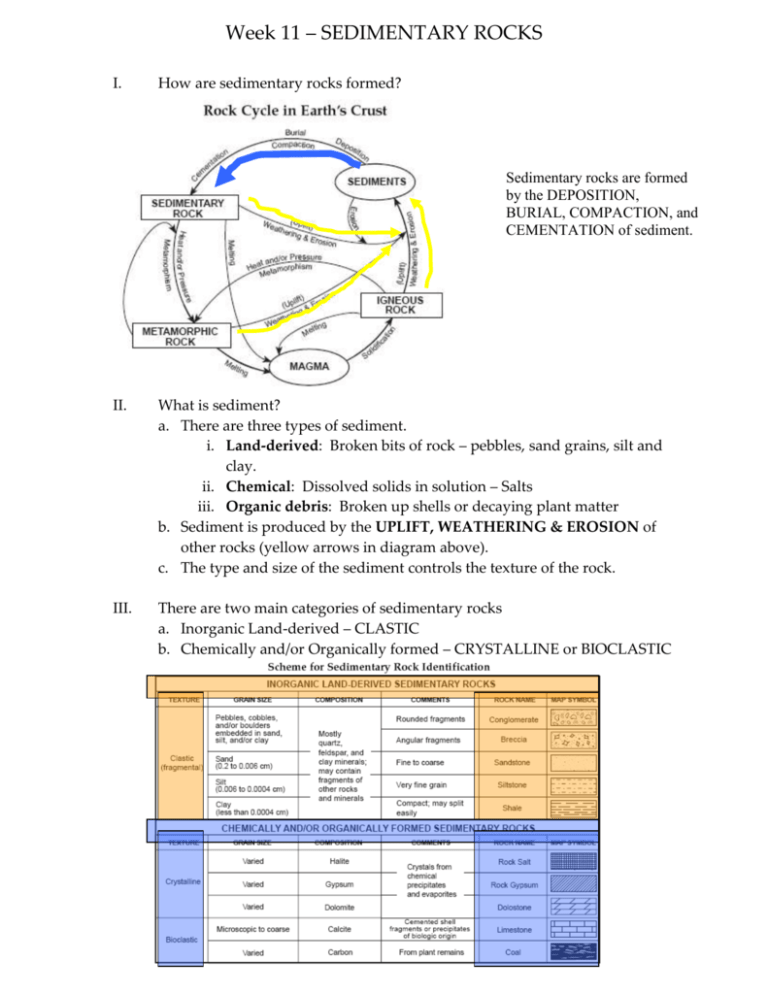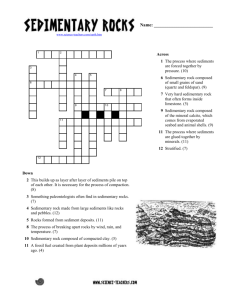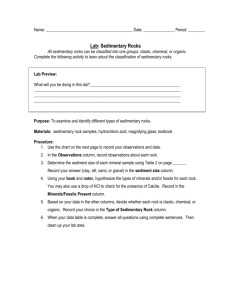Week 11 – SEDIMENTARY ROCKS
advertisement

Week 11 – SEDIMENTARY ROCKS I. How are sedimentary rocks formed? Sedimentary rocks are formed by the DEPOSITION, BURIAL, COMPACTION, and CEMENTATION of sediment. II. What is sediment? a. There are three types of sediment. i. Land-derived: Broken bits of rock – pebbles, sand grains, silt and clay. ii. Chemical: Dissolved solids in solution – Salts iii. Organic debris: Broken up shells or decaying plant matter b. Sediment is produced by the UPLIFT, WEATHERING & EROSION of other rocks (yellow arrows in diagram above). c. The type and size of the sediment controls the texture of the rock. III. There are two main categories of sedimentary rocks a. Inorganic Land-derived – CLASTIC b. Chemically and/or Organically formed – CRYSTALLINE or BIOCLASTIC IV. Sedimentary rocks hold clues to past life and to past environments. a. Sedimentary rocks may contain FOSSILS (evidence of past life). i. The fossils hold clues to past environment. ii. The fact that fossil shark teeth have been found on the summit of Mt. Everest tells us that those rocks were formed beneath sea level. iii. Rock Salt and Gypsums in Kansas indicate that the area was once covered by a shallow sea that evaporated. iv. v. Rock Salt, Gypsum, and Limestone in NYS tell us that parts of NY were once under water in the past. Those rock types coupled with fossils of marine (aquatic) plants and animals like the Eurypterid give strong evidence that parts of NY were once covered by shallow seas. V. VI. VII. vi. How can you recognize a sedimentary rock? a. Always ask “what is it made of?” and “how was it put together?” b. This rock is sedimentary because it …. i. Contains fossils ii. Is made of cemented particles iii. Has ripple marks or mud cracks What are the clues to past environment? a. Coal tropical swamps b. Limestone sea floor c. Shale still water, like the middle of a lake d. Sandstone beach or desert e. Siltstone Flood plain f. Conglomerate fast flowing water, like a stream bed Where are sedimentary rocks found? a. Most (~80%) of the rocks exposed on the surface of the Earth are sedimentary. Sedimentary rocks make a thin skin covering the crust. Earth’s crust is mostly igneous rock, but the very top of the crust is usually sedimentary. b. Sedimentary outcrops are usually seen in horizontal layers like the Grand Canyon. Layered outcrops of the Grand Canyon. c.









